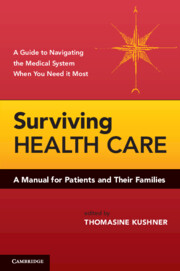Book contents
- Frontmatter
- Contents
- Contributors
- Preface
- 1 Letter to Patients
- 2 Becoming an Active Member of Your Health Care Team
- 3 Information That Will Help You with Advance Planning for Your Health Care
- 4 Responding to Medical Emergencies
- 5 What You Need to Know about Medical Errors
- 6 Being Informed When You Give Consent to Medical Care
- 7 Beware of Scorecards
- 8 Transplantation 101
- 9 When the Illness Is Psychiatric
- 10 On the Horizon
- 11 To Be or Not to Be – A Research Subject
- 12 Information That Will Help You Make Health Care Decisions for Adult Family Members
- 13 Caring for Individuals with Alzheimer's Disease
- 14 When the Patient Is a Child
- 15 Care of Elders
- 16 Being and Thinking
- 17 A Patient's Guide to Pain Management
- 18 The Hardest Decisions
- 19 What You Need to Know about Disasters
- 20 Making the Internet Work for You
- Appendix: Patient Individual Profile
- Index
8 - Transplantation 101
Negotiating the System
Published online by Cambridge University Press: 05 June 2012
- Frontmatter
- Contents
- Contributors
- Preface
- 1 Letter to Patients
- 2 Becoming an Active Member of Your Health Care Team
- 3 Information That Will Help You with Advance Planning for Your Health Care
- 4 Responding to Medical Emergencies
- 5 What You Need to Know about Medical Errors
- 6 Being Informed When You Give Consent to Medical Care
- 7 Beware of Scorecards
- 8 Transplantation 101
- 9 When the Illness Is Psychiatric
- 10 On the Horizon
- 11 To Be or Not to Be – A Research Subject
- 12 Information That Will Help You Make Health Care Decisions for Adult Family Members
- 13 Caring for Individuals with Alzheimer's Disease
- 14 When the Patient Is a Child
- 15 Care of Elders
- 16 Being and Thinking
- 17 A Patient's Guide to Pain Management
- 18 The Hardest Decisions
- 19 What You Need to Know about Disasters
- 20 Making the Internet Work for You
- Appendix: Patient Individual Profile
- Index
Summary
Kidney (or renal) transplantation involves removing a healthy kidney from either a deceased or living person and implanting it in a patient whose kidneys have failed, in the hope of restoring lost renal function. Transplantation is a complex process that begins with a detailed evaluation of a person with irreversible kidney failure to determine whether he or she is eligible for a transplant. For qualified candidates, the next step is to find a suitable kidney donor. Once this is accomplished, the transplant is performed, after which the recipient will need regular medical check-ups for the life of the transplanted organ (which is also called a “graft”).
Despite its complexity, transplantation generally is very beneficial, but it also poses risks. This chapter is designed to educate you about renal transplantation in the hope of reducing anxiety, developing realistic expectations, avoiding unpleasant surprises, and enhancing understanding so that you will be able to make informed choices at the many decision points along the way. We strongly believe that the more informed you are, the more you will advocate for yourself, and that the more responsibility you take for your own care, the more likely your transplant will succeed and the smoother will be the road to success.
The chapter uses a question-and-answer format, addressing what we believe are the most common and important concerns faced by people considering kidney transplantation. We note two caveats before we begin.
- Type
- Chapter
- Information
- Surviving Health CareA Manual for Patients and Their Families, pp. 96 - 123Publisher: Cambridge University PressPrint publication year: 2010

